- Can yoga cure IBS?
- Wind-relieving pose
- Gate pose
- Garland pose
- Bow pose
- Half-spinal twist
- Cobra pose
- Revolved abdominal twist
- Triangle pose
- Downward dog pose
- Seated forward bend
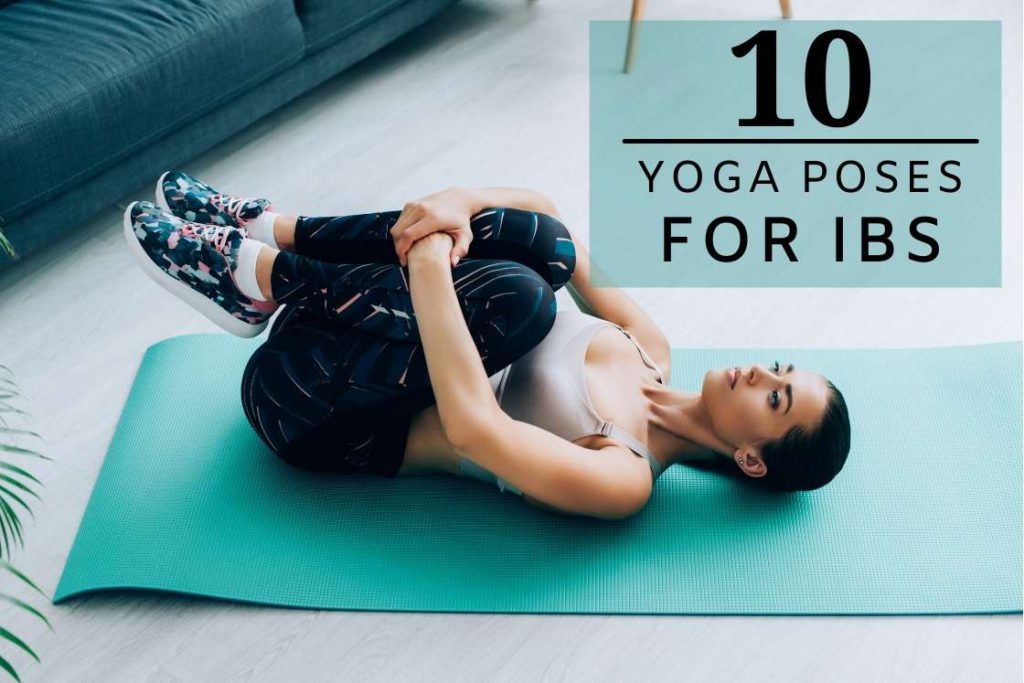
Irritable Bowel Syndrome (IBS) is a common digestive disorder with symptoms like abdominal cramps, bloating, gas, constipation, and diarrhoea. While it can be uncomfortable and affect daily life, simple lifestyle changes such as reducing stress and adding movement can help manage it.
Yoga is a natural way to ease IBS symptoms. It calms the nervous system, improves digestion, and helps reduce abdominal discomfort. Some yoga poses also support gut health by increasing circulation and encouraging regular bowel movements.
What causes IBS?
Irritable Bowel Syndrome (IBS) is often linked to a problem in the way the brain and gut communicate. When this connection is disrupted, the digestive system can overreact to normal processes like eating or digestion. This overreaction may lead to symptoms such as abdominal pain, diarrhoea, constipation, or bloating.
Stress and anxiety are major triggers. These emotional factors can cause the release of certain chemicals in the gut that affect how the muscles contract, slowing down or speeding up digestion. This imbalance can easily bring on IBS symptoms.
Gut infections may also be a cause. If you’ve recently experienced severe diarrhoea from a bacterial or viral infection, the lingering microbes can irritate the intestines and contribute to long-term digestive issues, including IBS.
Other contributing factors include hormonal changes, poor eating habits, irregular mealtimes, or consuming foods that irritate the digestive tract. These factors can make the gut more sensitive and increase the risk of IBS flare-ups.
Can yoga cure IBS (Irritable Bowel Syndrome)?
Yes, yoga can be a helpful practice for managing IBS symptoms. It supports the connection between the brain and the gut, which often becomes disrupted in people with IBS. By improving mind-body awareness and reducing stress, yoga helps bring balance back to the digestive system.
Iyengar yoga, a style that uses props to support the body, has shown promising results. In one study, a six-week Iyengar yoga program helped improve symptoms in 51 young adults with IBS. Its focus on alignment allows people to hold poses comfortably without strain, making it especially useful for those with sensitive digestion.
Gentle stretches and abdominal twists can relieve bloating, cramping, and discomfort. Traditional yogic practices like Uddiyana Bandha (abdominal lock), Agnisara, and Viparita Karani help stimulate digestion. Cleansing techniques such as Basti (colon cleansing) are also considered supportive for gut health when performed under guidance.
In addition, a 2015 review published in Evidence-Based Complementary and Alternative Medicine highlighted yoga as a remedial therapy for IBS, explaining how it helps regulate the brain-gut axis by calming the nervous system. The study also drew from ancient yogic texts like the Taittiriya Upanishad and Yoga Vasistha, showing how mental stress (Adhi) can lead to physical disease (Vyadhi) a concept that mirrors modern understanding of stress-induced IBS.
How yoga support IBS relief
- Improves blood flow to digestive organs
- Strengthens the gut and supports proper digestion
- Helps prevent chemical imbalances in the digestive system
- Reduces stress and anxiety, which often trigger IBS symptoms
- Regulates hormones related to digestion
- Promotes mindfulness and encourages healthier habits
Yoga is not a cure for IBS, but it can be an effective tool to manage symptoms and improve overall well-being when practised regularly.
Practice these 10 yoga poses for IBS relief
The following yoga poses are especially helpful for managing Irritable Bowel Syndrome and related digestive issues. Practising them regularly can help reduce symptoms like bloating, constipation, cramping, and indigestion. These gentle movements support healthy digestion and calm the nervous system, which plays a key role in gut health.
1. Wind-relieving pose (Apanasana)

This pose is performed lying on your back while drawing both knees toward the chest and wrapping your arms around them.
Wind-relieving Pose gently compresses the abdomen and massages the digestive organs. This action helps release trapped gas, ease bloating, and support smoother bowel movements. It is especially effective for those experiencing gas and abdominal tension from IBS.
How to do it
- Lie on your back with your arms resting beside you.
- Bend both knees and gently draw them toward your chest.
- Wrap your arms around your shins, pressing your thighs into your belly.
- Lift your head and chest slightly off the floor and bring your chin toward your knees (optional).
- You can stay still or gently rock side to side or back and forth to massage your lower back and abdominal area.
2. Gate pose (Parighasana)
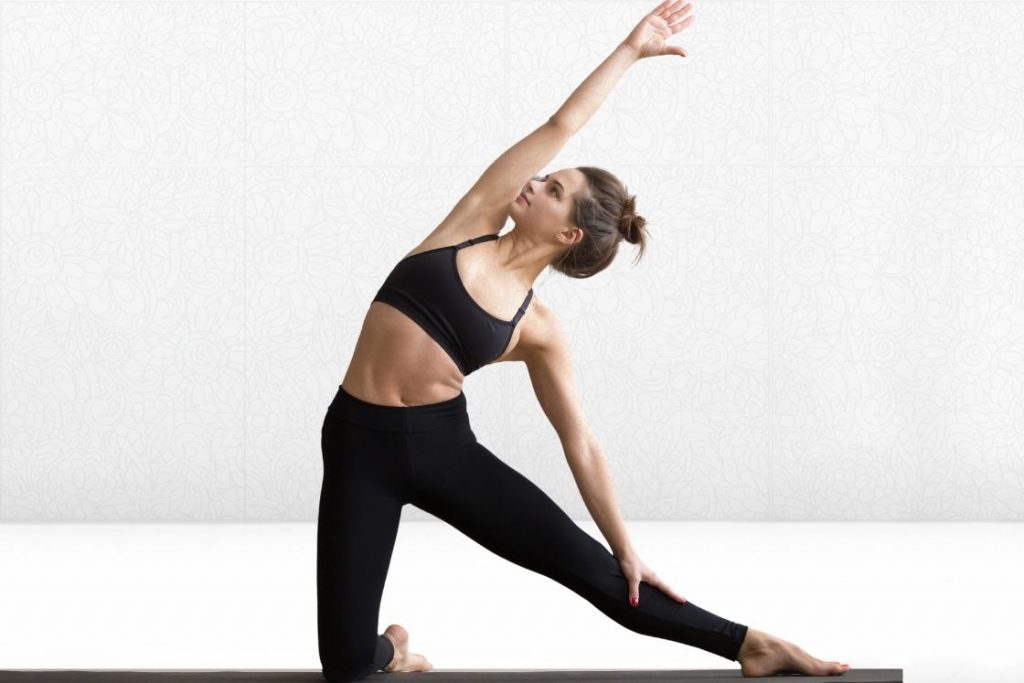
Gate Pose is done by kneeling on one leg while extending the other leg out to the side with the heel on the floor. The arms stretch overhead or to the side as the torso bends toward the extended leg, creating a deep side stretch.
This lateral stretch stimulates the abdominal organs, including the stomach, small intestine, pancreas, gallbladder, liver, and large intestine. It improves blood flow to the digestive system and helps ease bloating and sluggish digestion making it an excellent pose for relieving IBS symptoms.
How to do it
- Begin with kneeling tall on the floor keeping the knees hip-width apart and lengthening the spine.
- Exhale to stretch the right leg out to the right straightening the knee.
- Keep the right foot in line with left knee.
- Flexing right ankle point your toes to the ceiling and bring your heel to the floor.
- Place your right palm of the side of the right thigh.
- Inhale extend your right arm towards the ceiling passing through the ear.
- Exhale and bend laterally towards the right leg dragging the right hand towards the toes.
- Inhale opening the chest, turn it towards the ceiling, then exhale to turn the head to look up.
- Hold this stretch for 5-10 breaths.
3. Garland pose (Malasana)
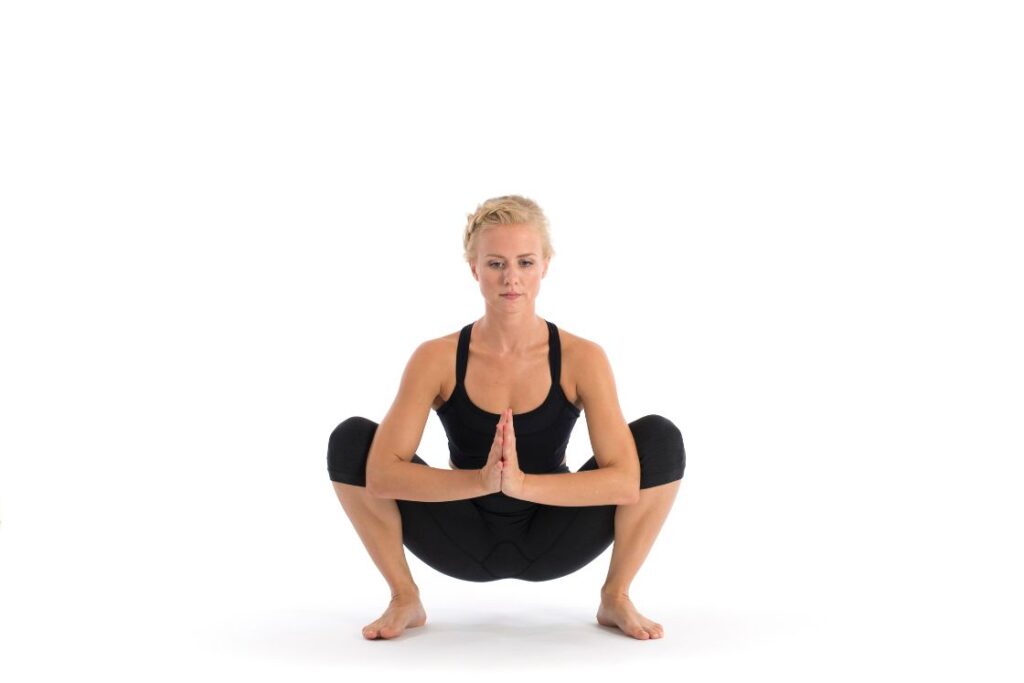
Garland Pose is a deep squat where the knees bend over the ankles, and the hips lower close to the floor while keeping the spine upright.
This posture gently compresses the abdominal area, stimulating the digestive organs and supporting healthy bowel movements. It helps relieve common IBS symptoms like constipation and bloating by promoting natural elimination and reducing tension in the lower belly..
How to do it
- Stand with your feet slightly wider than hip-width or mat-width apart.
- Bend your knees and lower your hips into a deep squat, bringing your seat close to the floor.
- Keep your heels grounded and your knees aligned over your ankles.
- Bring your palms together in a prayer position (Anjali Mudra) at the centre of your chest.
- Press your upper arms gently into the insides of your knees to help open the hips.
- Keep your spine straight and chest lifted as you hold the pose.
4. Bow pose (Dhanurasana)

Bow Pose is performed while lying on the stomach and lifting the chest, head, and legs off the floor by holding the ankles. The body balances on the abdomen, forming a bow-like shape.
This pose gives a deep stretch to the abdominal muscles and strengthens them, which helps relieve constipation and stimulate digestion. The gentle backbend also helps release stress and anxiety, making it a helpful yoga pose for both IBS and emotional triggers that may worsen symptoms.
How to do it
- Lie down on your belly keeping the arms by the sides.
- Bend your knees to take your feet towards the hips.
- Extend your arms backward to grab the feet with hands.
- Inhale to lift your head, chest, and shoulders off the floor.
- Simultaneously, pull the legs towards the head keeping only the belly pressing against the floor.
- Hold it for three deep breaths and then release. Repeat it two more times.
5. Sitting half-spinal twist (Ardha Matsyendrasana)
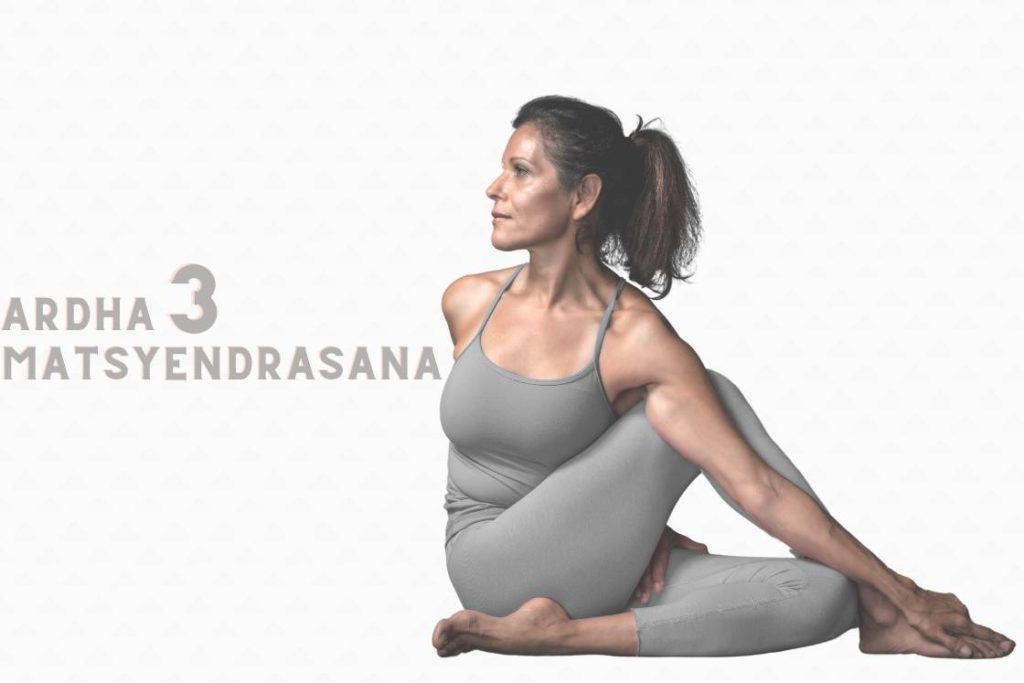
This seated twist is performed by crossing the legs so that the left foot rests near the right hip and the right foot is placed outside the left knee. The torso is then gently twisted to the right, using the arms for support and leverage.
This spinal twist stimulates the vagus nerve and activates the parasympathetic nervous system, which plays a key role in digestion and relaxation. The twisting motion also massages the abdominal organs, helping to reduce bloating, support detoxification, and improve circulation in the digestive tract. Regular practice of this pose can help ease IBS-related discomfort and calm the gut..
How to do it
- Sit extending the legs in front and keeping the back erect.
- Lift your right leg bending the knee to place the right foot outside the left knee.
- Flex the left knee on the floor to bring the left foot near the right buttock.
- Bend your right elbow to bring it outer side of the right knee.
- Pressing the right knee with the left arm reach the right ankle with the hand.
- Place your left hand behind you on the floor and twist the torso towards right.
- Turn your neck to look beyond the right shoulder enhancing the stretch.
6. Cobra pose (Bhujangasana)
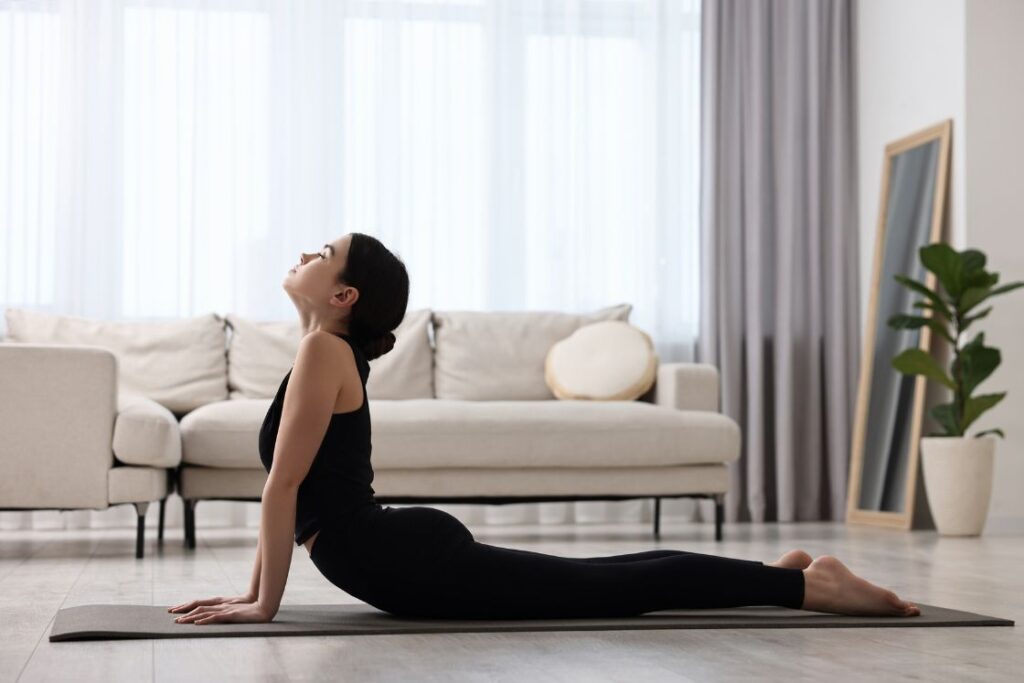
Cobra Pose is practiced lying on the belly and lifting the head, chest, and abdomen off the floor pressing the palms on the floor on either side of the chest.
It stretches the abdominals intensely, improves blood flow towards the digestive system. It is therapeutic in relieving constipation and releases intestinal gas. This stretching of the abdominal muscles strengthens them and also promotes better digestion, thus cure IBS.
How to do it
- Lie down in prone position keeping the arms by the sides and legs extended backwards.
- Bending your elbows, place your palms on the either sides of the chest on the floor.
- Inhale pressing the palms on the floor and squeezing the elbows together lift your head, chest, and abdomen off the floor.
- Arching the back drop your head backwards opening the chest fully.
- Hold this pose for three to five breaths and then release.
7. Reclining abdominal twist (Jathara Parivartanasana)
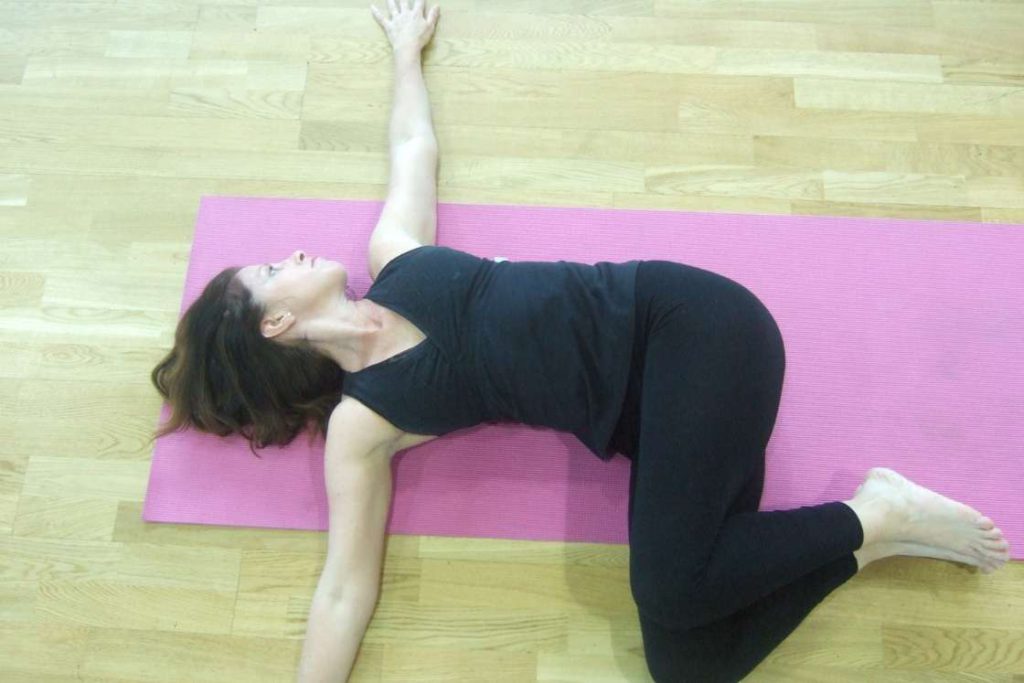
Practice reclining abdominal twist by lying on your back twisting the torso to one side bending the corresponding knee and lowering it to the alternate side on the floor.
It squeezes the abdominal cavity, promotes blood circulation, and aids in the peristalsis motion of the intestines. Hence, it facilitates better digestion and serves as an excellent yoga for IBS treatment.
How to do it
- Lie down on your back extending the legs and arms.
- Bend your right knee and squeeze to it the chest clasping the hands around shin.
- Release the right hand and extend the right arm at the shoulder level with palm facing the floor.
- Place your right foot behind the left inner thigh. Guide your right knee towards the floor passing over the left leg subtly pressing the left hand on the right knee.
- Turn your neck and torso to the right gazing the extended fingertips on the floor.
- Relax here for three to five breaths and exhale to release. Repeat it on the left side, switching the legs and arms position.
8. Triangle pose (Trikonasana)

It is a standing posture involving side-bending of the torso towards one leg and extending the corresponding arm to reach the foot. The other arm remains stretched overhead and the torso is twisted to look up.
This pose stretches the digestive organs, keeps the core muscles engaged, and promotes digestion. Also, it opens the chest, enhances lung capacity, improves breathing that relieves psychological stress. Hence, triangle pose can be practiced for IBS.
How to do it
- Stand separating the legs wide apart and arms by the sides.
- Turn your left foot 90° outwards and right foot slightly inwards.
- Spread your arms outwards at the shoulder level.
- Inhale and exhale while bending the torso sideways over the left foot with the left arm reaching the floor beside the foot.
- The right arm extends upwards with fingertips pointing towards ceiling.
- Turn your head to look towards the raised fingertips.
- Stay in this pose for up to 60 seconds then inhale to come up. Repeat the same on the other side.
9. Downward-facing Dog pose

Downward-Facing Dog is an inverted pose where the body forms an inverted V-shape. The hands and feet stay grounded as the hips lift upward, stretching the arms, legs, and spine.
This pose gently tones and stretches the abdominal muscles, supporting better digestion. As an inversion, it also increases blood flow to the brain, which has a calming effect on the nervous system. Together, these benefits make it a supportive posture for relieving IBS symptoms, especially those linked to stress and sluggish digestion.
How to do it
- Start on all fours with your hands shoulder-width apart and fingers spread wide.
- Tuck your toes under and exhale as you lift your knees off the floor.
- Raise your hips and tailbone toward the ceiling, forming an inverted V-shape.
- Straighten your legs and arms as much as comfortable, and press your heels toward the floor.
- Lower your head between your upper arms and gaze toward your navel.
- Hold the pose for 1 to 3 minutes, breathing steadily.
10. Seated forward bend (Paschimottanasana)
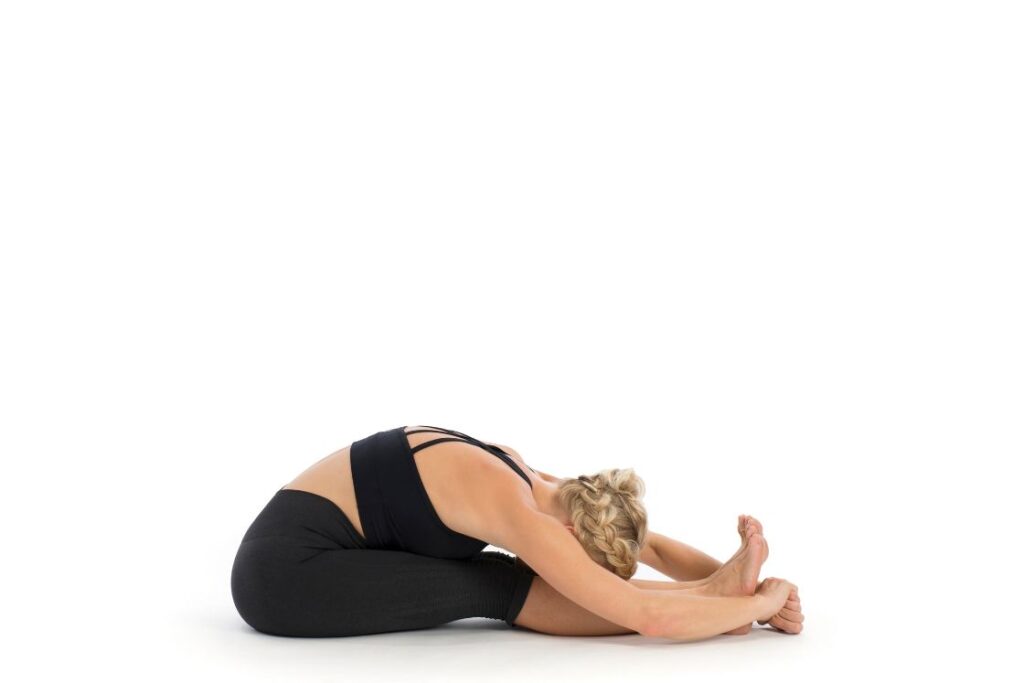
Seated Forward Bend is a calming pose done by sitting on the floor with legs extended straight in front and folding the upper body over the legs. The abdomen gently rests on the thighs, encouraging a deep forward stretch.
This pose stretches the abdominal area and stimulates the digestive organs and glands. It helps relieve several IBS symptoms including bloating, cramping, and constipation, while also calming the nervous system.
How to do it
- Sit on the floor with your legs extended straight in front of you. Keep your spine tall.
- Inhale and raise your arms overhead.
- Exhale and hinge forward from the hips, reaching toward your feet.
- Try to hold your toes or ankles, and bring your forehead toward your shins (if comfortable).
- Keep your back long and avoid rounding the spine.
Conclusion
Say goodbye to digestive discomfort with this simple and effective yoga practice for IBS. These poses not only support healthy digestion but also calm the nervous system—two key factors in managing IBS naturally.
By practising these yoga poses regularly, you can ease symptoms like bloating, cramping, and constipation while improving overall gut health. Over time, this routine can help you feel more balanced, energised, and in control of your well-being.
Make yoga a part of your daily routine and take a step toward long-term digestive health.




